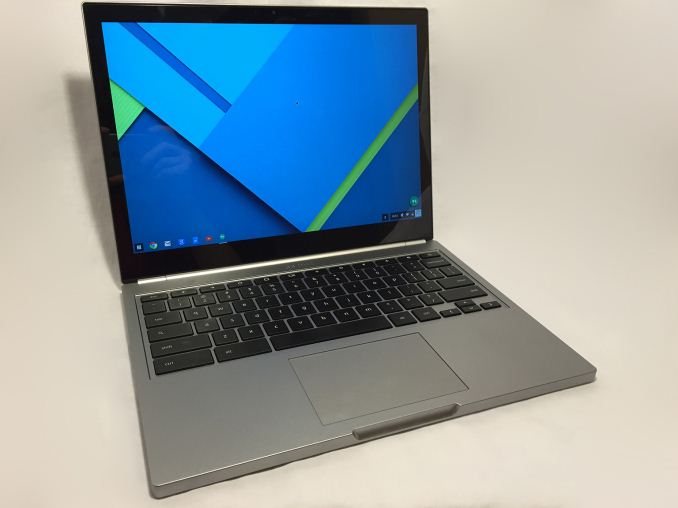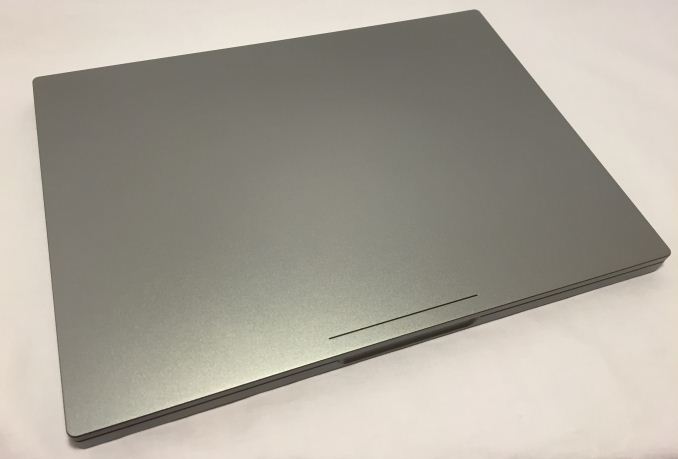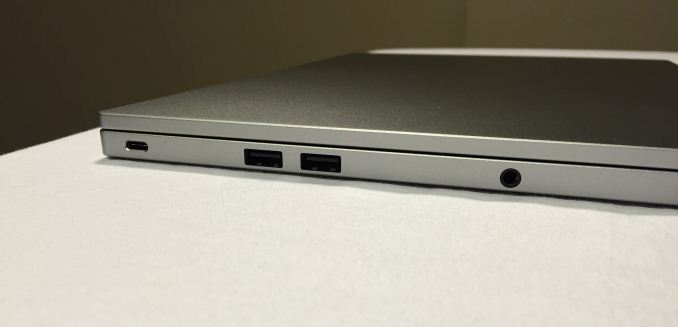The Chromebook Pixel (2015) Review
by Brandon Chester on March 16, 2015 8:00 AM EST- Posted in
- Laptops
- Chrome OS
- Chromebook
- Chromebook Pixel

Google's Chrome OS has always been similar to Microsoft Windows in how one company provides the operating system for many different manufacturers to use on their own devices. But two years ago, Google decided to create a Chromebook which was solely Google branded and designed. Although Chromebooks typically aim at the inexpensive part of the laptop market, this Google branded Chromebook had specifications that put it in line with high end Ultrabooks, and an equally high price tag. It was the original Chromebook Pixel, and its name referred to its 2560x1700 IPS display. At 239ppi it had the highest pixel density of any laptop in the world when it was released, and the rest of its specs were also impressive. In our original review of it, we concluded that it was an impressive laptop, but that its starting price of $1299 was quite a barrier to entry. In addition Chrome OS was more limited at that time than it is today.
That brings us to the new Chromebook Pixel which was released just last week. At first glance, you would be hard pressed to tell the difference between this new model and the old one. It has a similar high resolution display, and the same aluminum body with flat edges. But a look at the sides of the chassis will reveal a pair of highly versatile USB Type-C ports, and a figurative look inside will show one of Intel's new Broadwell CPUs which enables high performance and stellar battery life. Before we dive into the new Chromebook Pixel, I've compared it with the original Pixel from 2013 in the chart below.
| Chromebook Pixel (2013) | Chromebook Pixel (2015) | Chromebook Pixel LS | |
| Dimensions | 11.72 x 8.84 x 0.64" (297.7 x 224.5 x 16.3mm) | ||
| Mass | 3.35 lbs (1.52kg) | ||
| CPU | Core i5-3337U (2 cores + HT) | Core i5-5200U (2 cores + HT) | Core i7-5500U (2 cores + HT) |
| L3 Cache | 3MB | 3MB | 4MB |
| Base CPU Clock | 1.8GHz | 2.2GHz | 2.4GHz |
| Max CPU Turbo | 2.7GHz | 2.7GHz | 3.0GHz |
| GPU | Intel HD 4000 | Intel HD 5500 | Intel HD 5500 |
| System Memory | 4GB DDR3L-1600 | 8GB LPDDR3-1600 | 16GB LPDDR3-1600 |
| Storage | 32GB SSD | 32GB SSD | 64GB SSD |
| Display | 12.85" 2560x1700 IPS LCD | ||
| Battery | 59 Wh | ||
| Ports | 2 x USB 2.0, Mini DisplayPort, 3.5mm audio | 2 x USB Type-C, 2 x USB 3.0, 3.5mm audio, SD card | |
| Connectivity | 2x2 802.11a/b/g/n + BT 3.0 | 2x2 802.11a/b/g/n/ac + BT 4.0 | |
| Launch Price | $1299 | $999 | $1299 |
Some investigation into the Pixel's hardware reveals a few more details about it. The version sent by Google was the normal Intel i5 model, and although I don't expect the suppliers would be different for parts of the "Ludicrous Speed" model, it's still possible. In addition, parts like the RAM and SSD could be sourced from multiple vendors, although this is again unlikely due to the relatively small number of units that will be manufactured.
The original Pixel used a Sandisk iSSD, while this new Pixel uses an SSD made by Kingston. It's likely that it's still soldered to the motherboard which makes replacing or upgrading it impossible. Given that the Pixel can only be disassembled using suction cups and a great deal of force I'm not able to actually look inside to check. In addition, the i5 model of the Pixel uses two 4GB LPDDR3 modules which are manufactured by Samsung.
The chassis of the new Pixel is just as impressive as the previous model. The aluminum construction feels incredibly solid, and is heavy but not excessively so. When you first look at it, you'll notice that the device itself is slightly more square than other laptops, as a result of its 3:2 display. This square profile also extends to the sides and edges of the Pixel, which are as flat as can be. The top of the device also retains the LED light bar from the original model, which lights up in green, yellow, red, and blue colors and has a very Googley feel to it. Tapping twice on the top of the laptop will cause some of the LEDs on the light bar to turn on, and the color and number of LEDs gives you an approximation of how much battery life you have left. All these little details result in a really unique design, and its been clear since the original Pixel that Google wanted to create their own device instead of just carbon copying another laptop
Upon opening the Pixel, you'll be greeted by a uniquely shaped LCD display surrounded by a fairly thin bezel. Beneath it are the keyboard and touchpad, both of which felt great to use. The keyboard had a comfortable amount of key travel, very little movement back and forth, and large well spaced key caps that made typing a breeze. The keyboard also acts as the vent for the Pixel's fans, and the speakers are hidden underneath. Google uses sensors to detect when your hands are over the keys, and so the keyboard backlight is only on when you're typing. The touchpad is covered by a smooth piece of glass, and it was responsive and accurate in use, which is something that can't be said about many other laptops regardless of price. One small complaint I have is that Chrome OS doesn't seem to support pinch to zoom on the touchpad. If it does, I certainly couldn't find the option anywhere I looked.
That brings us back to the display, which is a 3:2 touch enabled IPS LCD. Chrome OS seemed reasonably responsive using the touchscreen, although much like on Android multi-touch gestures like pinch to zoom didn't track well to how your fingers were actually moving inward and outward. I don't think that the touchscreen is really a necessary input method on a laptop, and in my experience it's not comfortable in the slightest to hold your arm up and poke at your laptop display, but the option is there for users who desire it. Google has also improved the display hinge to reduce the bounce back of the display when touching it.
The sides of the pixel have all of the ports for expansion. Google clearly believes that users enjoy having ports on their laptops, and so each side of the Pixel has a USB 3.0 Type-C port, along with two USB 3.0 Type-A ports and an audio jack on the left side, and an SD card slot on the right side. Google provides several adapters that can be used to transform the Type-C ports to other existing interfaces, including HDMI, DisplayPort, and both female and male USB Type-A.
The build quality of the Chromebook Pixel certainly inspires a great deal of confidence in the rest of the machine, so lets continue our examination of the new Pixel with a look at the improvements Google has made to the display.













123 Comments
View All Comments
peterfares - Monday, March 16, 2015 - link
What Microsoft needs to do with the Surface is release another, larger keyboard for it that has a laptop-style hinge.chlamchowder - Monday, March 16, 2015 - link
It's called 'Surface' for a reason. A larger, hinged keyboard would kind of defeat the design concept.Also, Galaxy S6 running Windows 10....someone needs to port Prime95 to ARM. I want to know if it has overheating problems.
fokka - Monday, March 16, 2015 - link
it would still be detatchable and nobody would be forced to buy it, but to me a proper keyboard-base would make the surface much more buyable, than having to deal with that flimsy type cover and that awkward kickstand, which is simply a lesser workaround to a normal screen hinge.retrospooty - Monday, March 16, 2015 - link
"32GB on a laptop this expensive is just..................offensive"- Any Chromebook this expensive is just..................offensive".
fokka - Monday, March 16, 2015 - link
a surface laptop you say? you've got my attention!edhburns - Monday, March 16, 2015 - link
Every review of the Pixel gets the exact same comments. It's like the same people just follow reviews of this device for the express purpose of saying that it is not an option for them. Spoiler! This device is not for you. And I don't say that like the Apple people do. The Pixel is a limited production device that is produced primarily for Google Chrome OS developers. Everyone knows that this is too expensive for the average consumer. Even Google knows this. Very few of these devices will ever be made and the vast majority (~80%) will end up in the hands of Google employees.Flunk - Monday, March 16, 2015 - link
There are very few people who it is an option for. You need to both own a real computer in addition to this and want to fork out $999 for another, toy computer.edhburns - Monday, March 16, 2015 - link
As I said in my comment, this is not for normal people. It is for developers who work for Google or the very small subsection of a subsection of linux users who want a very well built laptop to run a linux build and don't mind the small storage cap.melgross - Monday, March 16, 2015 - link
Bah! This is not for developers.This is to establish Chrome as a high end computing OS, something that no one yet believes (for good reason). Like it or not, for something to succeed and be profitable, there needs to be a more expensive device out there. Keeping Chrome at the $/50 and below level isn't goi g to do that. It's just another race to the bottom, and that's how people will look at it; something to buy if you don't want to buy a slightly more expensive Windows device, or an even more expensive OS X device.
So people will look at these (Google hopes), and think of them as genuine competition to Windows and OS X, which it's really not.
Hanoveur - Monday, March 16, 2015 - link
Then you have people who don't use Chrome OS who think they know everything about Chrome OS. This was a machine given to people at the Google's developers conference. They made them available for sale on their web site. Do you see any keynotes or major ad campaigns trying to sell these? Would you have known about it if it wasn't for this review or other reviews on the web? I think the tech journalists are making more of a deal about this machine than Google is.BAH! lol.
BTW: I'm writing this on a Chromebook. I don't need an entire Windows installation to cruise the internet. That's like buying an entire car just because you needed a spare tire. If I need access to a PC, I just RDP to my machine upstairs. That's very rare though.